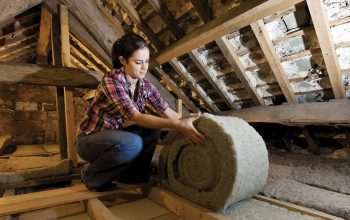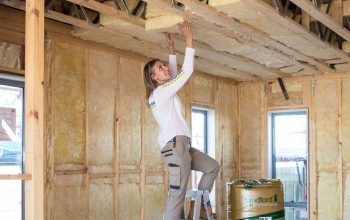Are you looking to improve your dormer house’s energy efficiency and comfort? Insulating your dormer can significantly impact maintaining optimal temperatures, reducing energy costs, and enhancing the overall livability of your space. In this article, we will explore various insulation techniques, materials, and tips for insulating a dormer house effectively. Whether considering a construction project, renovation, or simple home improvement, discover how insulation can make a difference in your dormer.
Insulating your dormer house is crucial for several reasons. Firstly, it plays a vital role in enhancing energy efficiency by preventing heat transfer and reducing energy consumption for heating and cooling. Secondly, insulation improves comfort by maintaining consistent temperatures and minimizing drafts. Additionally, insulation contributes to noise reduction, moisture control, and overall durability of the dormer structure.
Understanding Energy Efficiency in Dormer Houses
Dormer houses often have unique architectural features that can pose challenges to energy efficiency. Attic spaces, sloped ceilings, and skylights require specific insulation approaches. By understanding the energy dynamics of your dormer house, you can make informed decisions regarding insulation materials and techniques that best suit your needs.
Types of Insulation Materials for Dormer Houses
When it comes to insulating your dormer house, you have a variety of insulation materials to choose from. Some common options include fiberglass batts, spray foam insulation, cellulose insulation, and rigid foam boards. Each material has advantages and considerations, such as R-value, moisture resistance, and ease of installation. Consider consulting with insulation experts to determine the most suitable material for your dormer house.
Insulating Walls and Floors in Dormer Houses
Properly insulating the walls and floors of your dormer house is crucial for maintaining a comfortable living environment. Insulation between wall studs and floor joists can significantly reduce heat transfer and enhance energy efficiency. Techniques like blown-in insulation or foam insulation boards can help fill gaps and provide effective insulation coverage.
Insulating Ceilings and Roofs in Dormer Houses
Insulating the ceilings and roofs of your dormer house is essential for preventing heat loss or gain through the top of your living space. Consider using insulation materials that suit the unique design of dormer houses, such as spray foam insulation or rigid foam boards. Pay special attention to insulation installation around skylights and roof windows to minimize potential air leakage.
Enhancing Window and Door Insulation in Dormer Houses
Windows and doors are common areas of heat transfer in any house, including dormer houses. You can reduce drafts, noise infiltration, and heat loss by improving the insulation around windows and doors. Weatherstripping, caulking, and installing insulated window coverings can help create a more energy-efficient and comfortable dormer living environment.
Insulating Crawl Spaces, Basements, and Garages in Dormer Houses
In some dormer houses, crawl spaces, basements, and garages are integral parts of the overall structure. Insulating these areas is crucial for maintaining consistent temperatures throughout the house and preventing moisture issues. Consider using insulation materials designed for these specific spaces, such as foam boards or spray foam insulation.
DIY Insulation: Tips for Insulating a Dormer House Yourself
If you prefer a hands-on approach and have the necessary skills, you can tackle dormer house insulation as a DIY project. Before you start, make sure to gather the required tools, safety equipment, and insulation materials. Follow proper installation techniques, such as sealing air leaks, using protective gear, and ensuring adequate ventilation. However, it’s important to note that some insulation tasks are best left to professionals, especially when dealing with complex structures or hard-to-reach areas.
Hiring Insulation Contractors for Your Dormer House
For larger insulation projects or if you lack the time or expertise to handle the insulation process, hiring insulation contractors is a wise choice. These professionals have the knowledge, experience, and specialized tools to complete the job efficiently and effectively. When selecting an insulation contractor, consider factors such as their reputation, credentials, customer reviews, and pricing estimates.
Evaluating Insulation Services: Factors to Consider
When evaluating insulation services for your dormer house, several factors should be taken into account. These include the insulation company’s expertise in dormer house insulation, their range of services, warranty options, and energy-saving guarantees. Requesting quotes from multiple providers and comparing their offerings can help you make an informed decision.
Recommended Insulation Brands for Dormer Houses
Several insulation brands have established a reputation for providing high-quality insulation products suitable for dormer houses. Some popular brands include XYZ Insulation, ABC Insulation, and DEF Insulation. Conduct thorough research, read customer reviews, and consult with professionals to identify the best insulation brand that aligns with your dormer house insulation needs.
Case Studies: Successful Dormer House Insulation Projects
Looking at real-life examples of successful dormer house insulation projects can provide valuable insights and inspiration. These case studies showcase different approaches, materials, and techniques used to achieve optimal energy efficiency and comfort. Explore how other homeowners have addressed insulation challenges specific to dormer houses and learn from their experiences.
Calculating Insulation Costs and Potential Energy Savings
Determining the cost of insulation and estimating potential energy savings are essential steps in planning your dormer house insulation project. Factors such as the size of the dormer house, insulation material costs, and professional installation fees should be considered. Calculating potential energy savings based on insulation improvements can help you understand the long-term benefits and return on investment.
Conclusion
Insulating your dormer house is a wise investment that brings numerous benefits, including enhanced energy efficiency, improved comfort, and potential cost savings. By considering the unique characteristics of your dormer house, choosing the right insulation materials, and employing proper installation techniques, you can create a more sustainable and comfortable living space. Remember to consult with insulation professionals and gather multiple quotes to ensure you make the best decisions for your dormer house insulation project.








